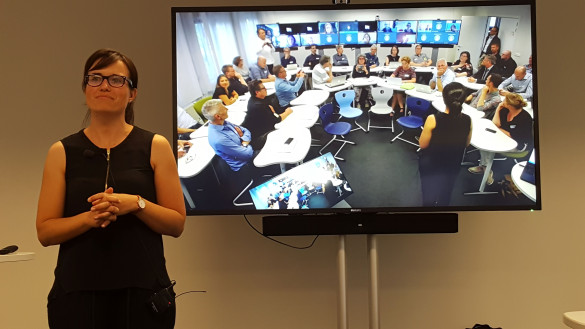Marij Veugelers
Passie voor vernieuwingen in het onderwijs is de rode draad in mijn leven. … Meer over Marij Veugelers
KULeuven onderzoek naar Hybrid Virtual Classroom
Learning and instruction in the hybrid virtual classroom: An investigation of students’ engagement and the effect of quizzes;
Binnen de KULeuven wordt onderwijskundig onderzoek verricht bij innovatieve onderwijsruimtes. Nu er in NL veel belangstelling is voor de Hybrid Virtual Classroom wil ik dit onderzoek onder de aandacht brengen.
Er zijn nog niet zoveel publicaties bekend en dit is een van de eerste, uitgevoerd in 2018, gepubliceerd in 2020 bij Elsevier in Computers and Education.
OPROEP:
Graag hoor ik of er binnen Nederland al onderzoeken zijn opgestart naar de Hybrid Virtual Classroom. We zijn binnen de SIG Learning Spaces bezig met het thema Hybrid Virtual Classsroom en benaderen het thema van alle kanten.
Hieronder de abstract en de conclusie van het artikel.
Learning and instruction in the hybrid virtual classroom: An investigation of students’ engagement and the effect of quizzes
Annelies Raesa, Pieter Vanneste, Marieke Pieters, Ine Windey,Wim Van Den Noortgate, Fien Depaepe
Abstract:
To deal with the current need for flexible learning trajectories giving access to a more diverse group of learners, synchronous hybrid virtual classrooms have been designed to connect both onsite students and remote students during synchronous teaching. Given synchronous blended learning is relatively new, there are only few studies that have investigated its use and effectiveness.
Furthermore, the existing literature is mostly exploratory and qualitative in nature.
This present study meets the need for empirical, theory-driven research.
More specific, this study has set up an experiment to investigate how different learning settings can affect students' relatedness, intrinsic motivation and learning achievement in the context of a synchronous learning space.
The Self-Determination Theory (SDT) namely stresses that relatedness is a contributing factor for intrinsic motivation and indirectly also predicts learning achievement. Although there are numerous studies using SDT in various contexts, only limited studies used this theory to examine learning in the hybrid virtual classroom comparing different learning settings and its effects on relatedness, intrinsic motivation and learning achievement.
The educational setting depends on whether students are physically present and thus attend the lecture face-to-face (F2F) or remotely (virtual), and on whether the setting is the same for all students (pure) or mixed (hybrid).
This study presents the results of an experimental within-subjects design study comparing the students' learning experiences as F2F versus virtual student in the pure or hybrid setting.
A mixed-methods approach is used including real-time measurements of intrinsic motivation next to retrospective self-report surveys and interviews. Also the effect of quizzes has been consistently investigated. The results show that although the hybrid virtual classroom is promising regarding flexibility in education as it gives students the choice where to attend the course, it is also the most challenging one to teach in and to learn in as a remote participant.
It has been found that both the relatedness to peers and the intrinsic motivation is the lowest in the hybrid-virtual setting. Yet, our results show that launching quizzes is positively related to all students’ motivation.
Further research that implements different kinds of quizzes and at different time intervals is necessary to validate this finding in the context of the hybrid virtual classroom.
Future research should also investigate how relatedness between the remote students and their on-campus counterparts can be improved by means of instructional interventions.
Conclusion
Given synchronous hybrid learning is relatively new, there is still a limited number of studies that have investigated its use and effectiveness and the existing literature is mostly exploratory and qualitative in nature. This study aimed to fill this research gap by setting up an empirical, theory-driven study. More specific, this study has set up an experiment to investigate from theself-determination theory how different learning settings can affect students' relatedness, intrinsic motivation and learning achievement in the context of a synchronous learning space.
We can conclude that the hybrid virtual classroom is very promising regarding flexibility in course attendance (Lakhal, et al., 2017) as students can choose to come to the campus or to attend the lecture from a location of their own choice. This flexibility also means that students are being exposed to a broader range of views and ideas, because this collaboration and connection between face-to-face and remote students creates richer learning experiences (Bell et al., 2014; Bower et al., 2015).
Yet, as confirmed in this study, it is also the most challenging one to teach in and to learn in as a remote participant and the learning environment is still open for improvement regarding the connectivity between face-to-face and remote students.
Technology-enhanced quizzes launched through the platform have been found to positively affect students' motivation in all learning settings, but further research that implements different kind of quizzes and during different time intervals is needed to validate this finding in the context of the hybrid virtual classroom.
The teacher in this study stated that the educational setting had not really influenced his style of teaching as he could easily start a dialogue with his students in the same way as he is used to do. This is somewhat contradictory with previous literature declaring that this new type of learning environment requires radical shifts in the teachers’ pedagogical methods in order to accommodate to the new technology (Cain, 2015; Ramsey et al., 2016).
Future research should investigate the effect of different pedagogical scenarios to more deeply investigate how the experience of the remote students in the hybrid setting can be approved by means of instructional interventions like collaborative (remote) breakout-sessions between F2F and remote students.

Passie voor vernieuwingen in het onderwijs is de rode draad in mijn leven. … Meer over Marij Veugelers

0 Praat mee